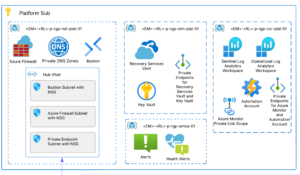Challenges with Public Cloud
One of the oldest problems facing cloud infrastructure services has been access control. Ensuring that resources can be accessed by users and services that need to access them and not by anything else has been problematic when those services are delivered through the public internet. Even as late as last year, cybersecurity data firm BinaryEdge.io listed over 35,000 publicly accessible and unsecured databases, most of which were cloud-hosted. That’s over 35,000 data breaches that have likely already happened because of misconfigured cloud resources. In short, the problem with the public cloud is that most resources shouldn’t be public.
Service Endpoints to the Rescue
Azure’s first step in service access control was the service endpoint. A service endpoint allows virtual networks to use private IP addresses to route traffic to an Azure service’s public IP address. But more importantly, it also allows you to deny traffic over the service endpoint unless it comes from its subnet. This effectively denies access to all traffic coming in from the public internet, making your Azure service accessible only to other Azure services and to selectively whitelisted IP addresses.
This approach has some limitations, potentially the biggest being that your service still has a public endpoint. It has a firewall in front of it, but if you only want other Azure services to connect to your private database, why should that database server allow traffic over its public IP address? Availability is another issue. Some Azure services, such as Azure Kubernetes Services, don’t support service endpoints. The network traffic pattern is also inefficient since Azure services using service Endpoints need to interact through public IP addresses. Finally, you have the issue of scope. Service Endpoints are scoped to the service, meaning any service in that subnet has access to the service. This means either a high degree of granularity in subnets, an administrative burden, or simply ignoring the access issue and hoping nothing happens. And while storage accounts have a third option, service endpoint policies, they only apply to storage accounts.
US MILITARY TRANSITIONS TRADITIONAL IT
AIS used Microsoft Azure services to migrate Windows 2016 Servers to Azure PaaS, reducing costs and scaling application performance as needed.
Private Endpoints: The Next Step
It’s not that Service Endpoints were a bad idea or were poorly implemented. Rather, the needs and usage of the public cloud have evolved rapidly. In response to evolving needs, Microsoft introduced another way to control connections to a service. Private Endpoints allow services to be accessible through their private IP addresses and Private Link, making connections between private IP addresses possible. And that doesn’t just mean private IP addresses in Azure. You can connect to your Azure instance from your on-prem network without leaving your firewall or using the public internet with the correct Domain Name Server (DNS) configuration.
To that end, there is no public IP address for a private endpoint. An Azure service can have both a private endpoint and a public endpoint. Creating a private endpoint does not automatically deny traffic over the public endpoint. However, if you take the extra step of denying all publicly routed traffic, you have isolated your Azure service far more effectively than if you had used a service endpoint. We can take this private connectivity a step further. It’s possible to integrate a private endpoint with a private DNS zone in Azure, resulting in private endpoints that can accept traffic from on-premises networks without routing through the internet. It’s as if the Azure service was part of the on-premises network. Finally, private endpoints solve our scoping and availability problems. Private endpoints are available on more services than service endpoints. For a full list, reference Microsoft documentation on Private Endpoint Availability and Service Endpoint Availability. Private endpoints can be scoped to a specific resource, such as a storage account, or even a sub-resource, such as specific blobs or tables in the storage account. Because Azure Active Directory can govern access to the private endpoint, this offers a very granular Role-Based Access Control (RBAC) for Azure resources.
Considerations
Private endpoints aren’t all sunshine and roses, however. They do come with some significant downsides to consider. First, they aren’t free. Private endpoints are charged by usage, while service endpoints are free. Secondly, private endpoints require more setup than service endpoints because you need to set up and configure DNS. Azure services have Fully Qualified Domain Names (FQDN) that resolve to public IP addresses, so you must configure DNS so that the public address resolves to the private IP of its private endpoint. In the end, it takes more to use private endpoints, but you get more when using them.
Putting It All Together
Private Endpoints involve a fair number of steps and a good bit of supporting infrastructure. Because of that, a practical implementation might help visualize how everything fits together. Fortunately, Microsoft has provided a thorough set of tutorials and quickstarts to help you get your hands dirty. If you try these, and I encourage you to do so, please remember to keep an eye on how services are charged and tear down your work so that you don’t receive a surprise bill.
Conclusion
Private Endpoints are an evolution of Azure infrastructure. The upfront configuration effort and ongoing service billing for use means that you should carefully consider whether your organization needs them. For example, if you need to block all internet traffic to a service while making services available to on-premises traffic, or if you need to secure specific sub-resources in your virtual network, Azure now offers that capability through private endpoints.






